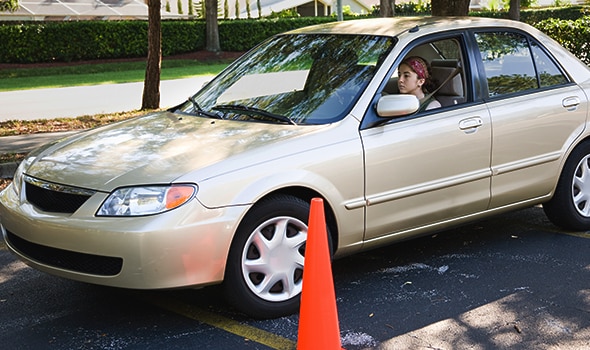So, you’ve got a new driver in your life, congratulations! There’s lots to be excited about, including less time driving them around, more free time for yourself, and them becoming more independent. But there are also a couple of tips that it’d be wise to share with your new driver so that they’re fully prepared for the different challenges that they may find on the road. Here are 10 helpful tips to share with drivers who are just starting out. And a few of these tips are great refreshers for anyone who has been on the road for many years.
The first and easiest tip is to practice driving with them. How does one practice driving? It’s simple, before heading out onto a busy highway or confusing downtown traffic filled with one-way roads, take the car to a quiet road with less traffic and practice braking, turning, accelerating safely, avoiding distractions, and using the blinkers. They’ll want to feel comfortable with the basics before heading into more challenging traffic situations and can learn from you when they make mistakes in a low-stakes environment.1
Before they even start the car, they should adjust the mirrors. Teach them how to adjust the rearview so that they can comfortably see out of the back window and the side mirrors to properly see what’s going on next to the car. Explain that mirrors are extremely important in helping reduce blind spots and keeping a driver safe. If mirrors are adjusted correctly the chances getting into an accident by not seeing a nearby car are lowered significantly. Make sure to also teach your new driver not to rely on backup cameras exclusively if their car has one. Backup cameras are a useful tool but have blind spots of their own and are not a substitute for using the mirrors in a car.
Teach them the proper way to hold the steering wheel, which is the “10 and 2” position. Use a light grip and let the wheel slide and turn between your hands using the push-pull method. Let them know that crossing their hands over the steering wheel could lead to injury in the event of an accident due to the airbag in the steering wheel (the rapidly inflating airbag could cause them to punch themself in the face or break an arm). Teach them to never let the steering wheel spin through their hands as the car straightens back because too much control is lost when doing so. It is important to use a light grip to maintain control of the vehicle should you hit a pothole or curb.2
Explain that the turn signal is one of the most useful tools when it comes to driving. They let other drivers know what your intentions are and signal where you plan on moving your vehicle. Encourage practicing using them no matter where your new driver is and even if there are no other vehicles around. Using the blinkers should become second nature to your new driver and will help keep them and others safe on the road.1
Want to learn a little bit more about all of the dashboard lights in your car?
Merging is one of the more stressful aspects of driving so it’s wise to prepare a new driver for what’s to come. Take a drive with them and when preparing to merge, make sure they look at what’s going on ahead of and behind them, have them identify a gap in cars and then increase speed to reach the gap. Make sure they use the blinkers to indicate their intentions and then merge. Once merged, they should leave a cushion of space (around 6-8 car lengths depending on your speed3) around the car so that the road can be safely navigated.4

When your new driver is thinking about driving, they probably aren’t worried about parking, but it’s something they’ll have to do at the end of every trip they make! Spend some time practicing parallel and perpendicular parking while using the mirrors with them. Two tips to follow are, when parking perpendicularly, stop once you see the curb in the side mirror. When parallel parking, practice parking in reverse to keep the curb in the side mirrors and avoid damaging your hubcaps.5 There are lots of potential places to practice parking, including any big parking lot (think movie theaters, strip malls, doctors’ offices, etc.). Practice with cones or cans so they get the feel of where the tires are and make sure not to solely rely on the backup camera (if your vehicle has one).

If the weather is extremely bad, it’s better not to drive at all. But rain, wind, sleet, and snow can happen at any time, including when a trip has already begun. If there is precipitation, make sure they know that headlights need to be on, to increase the following distance behind other cars, to drive a bit slower and to stay alert and attentive to the weather and the drivers around them.6
The safest way to drive is to follow the speed limit and keep a safe distance from other cars. But in some instances, they will find themself behind a vehicle that is driving under the speed limit. When this occurs, teach them to use the left lane to safely pass and get back into the right lane once they’ve done so. This keeps the flow of traffic moving and is courteous to other drivers. They’ll also get to wherever they’re going quicker.1
Teach that driving predictably equals driving safely. This means driving in a manner that makes sense to the drivers around them. The easiest way to do this is to stay alert while driving and to use turn signals when needed. Leave distractions out of reach, especially cell phones. Explain to them how to handle scenarios such as finding yourself getting close to an exit that you intend on using but being in the far-left lane, the way to predictably handle the situation is to use your blinkers, slow down, and get off if possible. If you are in a scenario where you are going to be forced to do something unpredictable, it’s better to wait and take the next exit or make a different turn for the safety of yourself and those around you.7
Drive safely by following the 5 Ways to Keep Your Mind Active on the Road.
With the responsibility of driving comes the responsibility of maintaining a vehicle. A good way to make sure a new driver can be the best driver possible is to make sure they know how to care for their vehicle. If tires aren’t filled with air or turn signals don’t work, it will be difficult for them to be a predictable driver on the road. Help familiarize them with their car and how to best take care of it so they can be the best possible driver they can be.
Here are some basic car maintenance tips to keep your car humming.
Some final driving tips and reminders for new and experienced drivers include, in most states having your headlights on is required from sunset to sunrise. If the speed limit is not posted in a residential/school district, it is 25mph, on a rural highway it is 55mph, and on an interstate highway it is 70mph. And the rules of a four-way stop are, right of way first goes to the vehicle that arrived at the four way stop first, then yield to the car on the right. The car driving straight has the right of way over the car that’s turning, and the car turning right has the right of way over the car turning left. It’s imperative that you use your turn signals at four-way stops so that the drivers around you know what you’re doing.8 9 10
Sharing these tips will help your new driver be a safe and predictable driver and will hopefully help ease some of the nerves you might have as they head out onto the road on their own. The Synchrony Car Care™ credit card can help you be prepared for all your car care needs as well as any that may pop up for your new driver. From the everyday like gas and regular maintenance, to the unexpected like towing, new tires, or larger repairs. Learn more about the Synchrony Car Care credit card and apply today.

